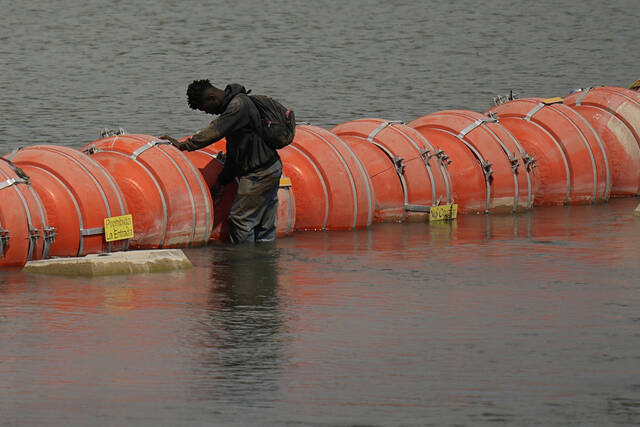Anti-migrant buoys ‘drifted’ into Mexico, Abbott says after Texas quietly moved them back
WASHINGTON — Texas has quietly moved its anti-migrant buoys to the American side of the Rio Grande, and Gov. Greg Abbott said Monday the 1,000-foot barrier had simply “drifted” into Mexican territory.
The governor offered no apology to Mexico, which complained for weeks about the violation of its sovereignty, nor any explanation for why the buoys were installed so close to the Rio Grande midpoint for that to have happened.
Last Tuesday, the Justice Department showed a federal court evidence that roughly 80% of the barrier was on the Mexican side of the border, which Texas officials had previously denied.
The buoys are attached to concrete anchors using 12-meter chains. The river is no deeper than 4 feet in that area, meaning the buoys can shift quite a bit in the current.
Crews were working on the buoys Monday near Eagle Pass, hours before Abbott arrived for a news conference. Joined by four fellow Republican governors, he blasted President Joe Biden’s immigration policies and defended the state’s tactics, which includes razor wire, state police and National Guard.
The $850,000 floating barrier was installed six weeks ago.
An 1899 law prohibits construction in a waterway without federal approval. Abbott says Texas needs no such permission because it’s under “invasion” by migrants and drug smugglers.
“We are fully authorized by the Constitution to do exactly what were are doing, and that is to secure the border,” he said Monday.
The Justice Department issued a lengthy rebuttal to that contention last week. Federal courts have always rejected efforts to equate immigration with the emergency powers afforded states in case of invasion.
The Justice Department also says the barrier harms relations with the largest U.S. trading partner — even more so once the border violation became apparent. The fact that Texas decided to rectify the error without a heads-up, let alone permission, the Justice Department told a court Friday after learning the work had begun, added to a growing list of “ongoing and flagrant violations” by the state.
U.S. District Judge David Ezra, a Reagan appointee, will hear arguments Tuesday morning in Austin on the DOJ lawsuit aimed at forcing Abbott to remove the buoys and halt further construction in the river that defines the Texas-Mexico border.
Last Tuesday, the Justice Department filed a survey from the International Boundary and Water Commission, the binational agency that controls the river, showing that roughly 80% of the barrier was on the Mexican side.
On Thursday night, a tipster alerted the IBWC that work was being performed on the barrier.
The next morning, IBWC dispatched a civil engineer, Evelio Siller. His affidavit describes excavators and workers repositioning concrete blocks that anchor the barrier.
Texas officials have yet to explain how the barrier ended up on the wrong side of the border. Nor have they said how much it cost to correct that error.
Frank Fisher, spokesman for the U.S. Section of the IBWC, said Monday the agency “is monitoring the recent activity involving the Texas floating barrier in the Rio Grande near Eagle Pass,” and referred further questions to the Justice Department.
The state paid a company called Cochrane USA $850,000 to install the barrier.
Abbott scheduled a 2 p.m. news conference with Iowa Gov. Kim Reynolds, Nebraska Gov. Jim Pillen, Oklahoma Gov. Kevin Stitt and South Dakota Gov. Kristi Noem to defend Operation Lone Star, Texas’ $10 billion border security effort, and air criticism of President Joe Biden’s border policies.
“The United States had no advance notice that Defendants would be performing additional work on the Floating Barrier. When questioned by counsel this afternoon, Defendants admitted that Texas is presently repositioning the Floating barrier within the river,” the Justice Department told the court Friday. “Texas’ newly resumed, unauthorized construction activities in the Rio Grande underscore why this Court should” order Texas to remove the barrier.
Mexico’s top diplomat raised complaints about the buoys directly with Secretary of State Antony Blinken and Homeland Security Secretary Alejandro Mayorkas during meetings in Washington two weeks ago.
Migrant advocates, Democratic lawmakers and Mexican officials say the buoys add to the risk for migrants, forcing those intent on crossing the river to do so at deeper and more dangerous parts.
The river is about 200 feet wide and no more than 4 feet deep where the barrier was placed, 2 miles downstream from Eagle Pass.
It’s attached by 12-meter chains that allow it to shift position with the current.
Several migrants have drowned near the buoys since they were installed about six weeks ago.
Texas has also installed razor wire along 60 miles of the border, and migrants have been entangled and cut.
Remove the ads from your TribLIVE reading experience but still support the journalists who create the content with TribLIVE Ad-Free.

